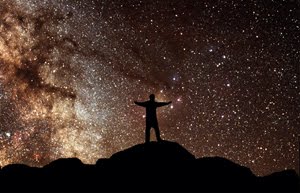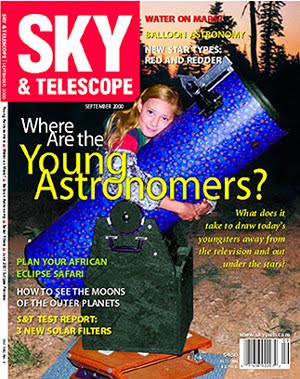Wednesday the 16th of December, about a dozen bay area amateur astronomers held a close-to-town star party at Montebello Regional Open Space Preserve on the eastern ridge of the Santa Cruz mountains above Palo Alto. The day had set record heat temperatures for the area... very much a spring day. There had been talk of going to Fremont Peak that evening, but reports from Tuesday night were of very strong winds across the entire bay area at elevations above 1,000 feet, and there was the chance that conditions, while improving, might not be calm enough to warrant an hour drive each way, for what could have been disappointment. So, Montebello was the choice... allowing local observers to "risk" only 15 to 30 minutes drive with skies significantly better than down in the light hole.
Early views of Jupiter were outstanding through Peter's 14.5" Starmaster and the two 6" f/7 brand new AP's that were already set up. It was not even dark, but the views of Io sitting on the darkened limb of Jupiter, and the huge NEB festoons, were outstanding. If I had gone to Fremont Peak, I would have packed my larger Dob, but tonight my goal was to continue my near-town Herschel 400 hunt with a 10" f/5.6 Dob. Just for the heck of it, I had done a very fine collimation during the afternoon, and the results on Jupiter and the sharp point of stars made it worth the effort. The view of the small white disk of Io actually intruding onto the disk, then completely against the disk of Jupiter was, fantastic. Nice way to start the night!
As the sky darkened, Mojo (Morris Jones) arrived. He shared views through the various scopes. Others would arrive to join Peter, John, Mike and me. By about 8 p.m., there was quite a star party going on. I'm sure it was the warm December temps and pent up photon deprivation that prompted such a good turnout.
I decided first to look for an object I had seen last week, NGC615 in Cetus, just to get started up again. I had my laptop computer running The Sky as my chart. I decided to go to a higher mag eyepiece, since I was using a smaller scope and wanted near the same field size as I am used to, so I put in the 12mm Nagler and used that almost exclusively for finding and viewing during the night. Well, NGC615 was not there. Well... yes it was, but it was confusing. The star pattern on-screen was not matching the eyepiece view. Mojo and I kept looking and saying it was wrong. But, it turns out the view was correct after all... several of the stars we were looking for were, upon closer inspection of the on-screen descriptions, non-stellar. These were super-dim little babies that would never show up in the bright skies of Montebello. With those items removed form the star pattern, things matched up.
So, on to the other objects. I completed the November Herschels by viewing galaxies (all numbers are NGC) 185 and 278, open clusters 225, 436, 457, 559, 637, 654 and 659 in Cassiopeia. My notes indicate that 663 was very nice, and in fact, another observer (David) had just been looking at it in a pair of Canon 15x40 image stabilizer binoculars. I asked to use the binos. Ever so carefully, he placed the strap around my neck, and I enjoyed the view. They are very nice (and expensive) binos. I certainly understand his being so cautious "handing them off"! One of the other clusters was fun to see (well, several were fun, but...) 436 was right at the feet of the "ET Cluster" (457). I used 436 as an example for other observers of how nicely software works to identify star fields from the eyepiece. Peter and I matched the view literally star for star, between eyepiece and computer screen. There is no doubt about "having" an object when there is such a high degree of confirmation.
For me, observing parties are a combination of serious "hunting" observing (scope and Telrad star hopping) and socializing. I spent quite a bit of time looking through other equipment, which helped keep me fresh at the eyepiece from about 6 p.m. until after 1 a.m. That's a long observing session.
The next objects on the list was NGC 40, the nice little fuzzy planetary in Cepheus. This was an easy target to hit, and a fairly bright "no mistaking it" object. On to the remaining objects in Cetus. NGC 157, and 247 were galaxies, and 246 a very often visited large planetary nebula. 247 was elusive, and I spent far too much time trying to see it. David saw it in his 7" Starmaster, Peter in the 14.5", but I cannot say a definite "yes" in the 10". Oh well, another night... what I got last night was a "maybe."
Now I moved down to Sculptor. I can hardly believe old Herschel saw NGC 613. It must have been a horizon grazer for him. But, it was not difficult to see from Montebello. The object is located nicely on a direct line between Alpha Sculptor and Nu Fornax. The last object on the November list was NGC 598 in Triangulum. I thought to myself, okay, up high overhead, bound to be something dim, but at least it is in the right part of the sky. NGC 598 is also known as M 33. We could see it (detect it) naked eye. Naked eye at Montebello? Hey... that sounds pretty damned transparent, doesn't it?
About that time, Peter pulled the Eskimo Nebula in with the 14.5". At about 220 diameters, there were two nicely defined shells, obvious in the object. People were quite jazzed at seeing this sight. Such clarity was a first for me. Nice scope Peter! I then suggested NGC2371/2372, a bi-lobed planetary up toward Castor and Pollux in Gemini. With enough power, it was easy to see two distinct lobes on the little gray fella.
Back to my scope, I pulled in M 33. Not a bad view, considering the location. With the galaxy up high overhead, the entire central concentration of the galaxy was visible. Hints of spiral arm were in evidence. One and maybe two of the HII regions shown. Oh... to be in a black sky, what a sight this would be!
Now, I moved to the December list of Herschel objects. The way I divided the H400 is, 2 hours of R.A. at zenith at midnight, per month. December's objects were now up high enough that the entire list was available to view.
First was NGC 891, the fine edge on spiral galaxy in Andromeda. In this sky, it was barely visible. I remember looking at it at Pacheco a few months ago, on a cold night, when the dust lane in this galaxy looked black as ink, bisecting the object's nice needle shape. Tonight was a "detect it" night.
I moved back to Cassiopeia, to open cluster NGC 1027, then back down to Cetus for a series of galaxies - 908, 936, 1022, 1052 and 1055. In the process of star-hopping, I couldn't help but notice that it was easier to see Mira than a few months ago... am I right here... has it suddenly brightened? Bordering Cetus is Eridanus, and I moved on to two more galaxies - 1084 and 1407. NGC 1407 was remarkable in that I could also pick up NGC 1393 and 1400 in the same field of view. I wonder what the real magnitude of 1393 is, since The Sky lists it at mag 14, and I don't think I'm picking up that dim an object in a 10" near the city.
I heard some commotion over by Peter's scope. I heard the word Horsehead. Really? From "in-town" (so to speak)? Nah. I went over. David was glued to the eyepiece. He was there perhaps 30 seconds, but it seemed like 10 minutes... I couldn't wait to see if it was true. Well, black as ink, there was a clear view of the elusive object, framed against a brighter background. Not just a "maybe" amorphous darkening, but this time, a distinct black area with shape. The H-Beta filter sure helps! Another nice view in Peter's scope. He wins "view(s) of the night" award with the Eskimo and Horsehead. Outstanding!
By now, the hours of observing were beginning on wear on me, and it was late on a work night All I had left on my December list were several objects, mostly open clusters, in Perseus. Many of these were dim and needed to be confirmed by their surrounding star fields. However, the first two seemed familiar... NGCs 869 and 884. Sure 'nuff, the Double Cluster. The H400 is fun in that many bright familiar objects are in it, Messier and non-Messier, and after looking at the dim "is-it-there" stuff, big and bright is a nice surprise and change of pace. My next object was a galaxy, NGC 1023, but I took no notes on this one... a sure sign of fatigue. But I was able to finish up on NGC's 1245 and 1342, both nice open clusters. I always talk-down open clusters, until I begin getting a good dose of them. Then I find, like galaxies, clusters too have character. Some are big and bright, easy to detect and confirm, others are the faintest wisps of stars, looking like a bit of frost on glass in the cold of winter.
The night was a complete success. Other than my marine cell battery dying, and then my truck battery draining, everything was just right. Even the weather cooperated... no dew, no cold... it was like a warm spring night, all night at Montebello, when really, by all rights, we could have been dressed like Eskimos in winter.











